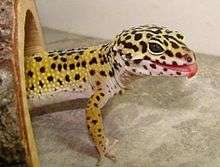Eublepharidae
The Eublepharidae are a family of geckos (Gekkota) consisting of 30 described species in six genera. They occur in Asia, Africa and North America.[1][2][3][4] Eublepharid geckos lack adhesive toepads and, unlike other geckos, have movable eyelids, thus commonly called eyelid geckos. Leopard geckos (Eublepharis macularius) and African fat-tailed geckos (Hemitheconyx caudicinctus) are popular pet lizards.
| Eublepharidae | |
|---|---|
 | |
| Common leopard gecko (Eublepharis macularius) | |
| Scientific classification | |
| Kingdom: | Animalia |
| Phylum: | Chordata |
| Class: | Reptilia |
| Order: | Squamata |
| (unranked): | Gekkomorpha |
| Family: | Eublepharidae Boulenger, 1883 |
| Genera | |
|
See text | |
Genera
The following genera are considered members of the Eublepharidae:
- Aeluroscalabotes - cat gecko
- Coleonyx - (8 species)
- Eublepharis - (6 species)
- Goniurosaurus - (19 species)
- Hemitheconyx - (2 species)
- Holodactylus - (2 species)
gollark: too
gollark: ```haskelladd1 = (5 -)```
gollark: Aaargh.
gollark: Er, `add 1`.
gollark: Not add1.
References
- Grismer, L.L. 1988. Phylogeny, taxonomy, classification, and biogeography of eublepharid geckos. In: Phylogenetic Relationships of the Lizard Families (R. Estes & G. Pregill, eds), pp. 369– 469. Stanford University Press, Stanford, CA.
- Gamble, Tony; Greenbaum, Eli; Jackman, Todd R.; Russell, Anthony P.; Bauer, Aaron M. (June 27, 2012). "Repeated Origin and Loss of Adhesive Toepads in Geckos". PLOS ONE. 7 (6): e39429. Bibcode:2012PLoSO...739429G. doi:10.1371/journal.pone.0039429. PMC 3384654. PMID 22761794.
- Gamble, T.; Bauer, A.M.; Colli, G.R.; Greenbaum, E.; Jackman, T.R.; Vitt, L.J.; Simons, A.M. (February 2011). "Coming to America: Multiple Origins of New World Geckos". Journal of Evolutionary Biology. 24 (2): 231–244. doi:10.1111/j.1420-9101.2010.02184.x. PMC 3075428. PMID 21126276.
- Gamble, T.; Greenbaum, E.; Jackman, T.R.; Bauer, A.M. (August 2015). "Into the light: Diurnality has evolved multiple times in geckos". Biological Journal of the Linnean Society. 115 (4): 896–910. doi:10.1111/bij.12536.
| Wikispecies has information related to Eublepharidae |
This article is issued from Wikipedia. The text is licensed under Creative Commons - Attribution - Sharealike. Additional terms may apply for the media files.